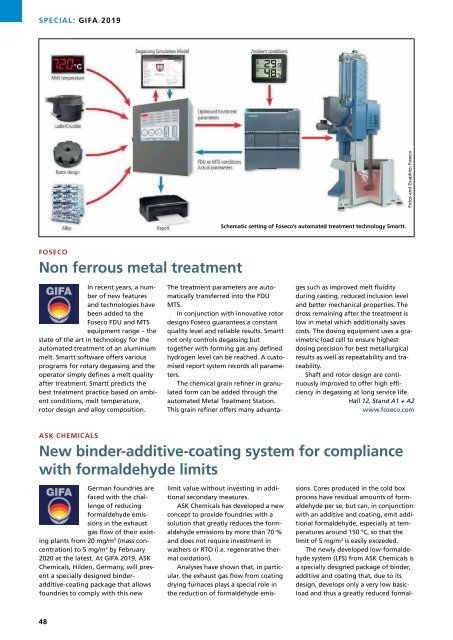CPT International 02/2019
- No tags were found...
You also want an ePaper? Increase the reach of your titles
YUMPU automatically turns print PDFs into web optimized ePapers that Google loves.
SPECIAL: GIFA <strong>2019</strong><br />
Fotos and Graphics: Foseco<br />
Schematic setting of Foseco’s automated treatment technology Smartt.<br />
FOSECO<br />
Non ferrous metal treatment<br />
In recent years, a number<br />
of new features<br />
and technologies have<br />
been added to the<br />
Foseco FDU and MTS<br />
equipment range – the<br />
state of the art in technology for the<br />
automated treatment of an aluminium<br />
melt. Smartt software offers various<br />
programs for rotary degassing and the<br />
operator simply defines a melt quality<br />
after treatment. Smartt predicts the<br />
best treatment practice based on ambient<br />
conditions, melt temperature,<br />
rotor design and alloy composition.<br />
The treatment parameters are automatically<br />
transferred into the FDU<br />
MTS.<br />
In conjunction with innovative rotor<br />
designs Foseco guarantees a constant<br />
quality level and reliable results. Smartt<br />
not only controls degassing but<br />
together with forming gas any defined<br />
hydrogen level can be reached. A customised<br />
report system records all parameters.<br />
The chemical grain refiner in granulated<br />
form can be added through the<br />
automated Metal Treatment Station.<br />
This grain refiner offers many advantages<br />
such as improved melt fluidity<br />
during casting, reduced inclusion level<br />
and better mechanical properties. The<br />
dross remaining after the treatment is<br />
low in metal which additionally saves<br />
costs. The dosing equipment uses a gravimetric<br />
load cell to ensure highest<br />
dosing precision for best metallurgical<br />
results as well as repeatability and traceability.<br />
Shaft and rotor design are continuously<br />
improved to offer high efficiency<br />
in degassing at long service life.<br />
Hall 12, Stand A1 + A2<br />
www.foseco.com<br />
ASK CHEMICALS<br />
New binder-additive-coating system for compliance<br />
with formaldehyde limits<br />
German foundries are<br />
faced with the challenge<br />
of reducing<br />
formaldehyde emissions<br />
in the exhaust<br />
gas flow of their existing<br />
plants from 20 mg/m 3 (mass concentration)<br />
to 5 mg/m 3 by February<br />
2<strong>02</strong>0 at the latest. At GIFA <strong>2019</strong>, ASK<br />
Chemicals, Hilden, Germany, will present<br />
a specially designed binderadditive-coat<br />
ing package that allows<br />
foundries to comply with this new<br />
limit value without investing in additional<br />
secondary measures.<br />
ASK Chemicals has developed a new<br />
concept to provide foundries with a<br />
solution that greatly reduces the formaldehyde<br />
emissions by more than 70 %<br />
and does not require investment in<br />
washers or RTO (i.e. regenerative thermal<br />
oxidation).<br />
Analyses have shown that, in particular,<br />
the exhaust gas flow from coating<br />
drying furnaces plays a special role in<br />
the reduction of formaldehyde emissions.<br />
Cores produced in the cold box<br />
process have residual amounts of formaldehyde<br />
per se, but can, in conjunction<br />
with an additive and coating, emit additional<br />
formaldehyde, especially at temperatures<br />
around 150 °C, so that the<br />
limit of 5 mg/m 3 is easily exceeded.<br />
The newly developed low-formaldehyde<br />
system (LFS) from ASK Chemicals is<br />
a specially designed package of binder,<br />
additive and coating that, due to its<br />
design, develops only a very low basicload<br />
and thus a greatly reduced formal-<br />
48

















